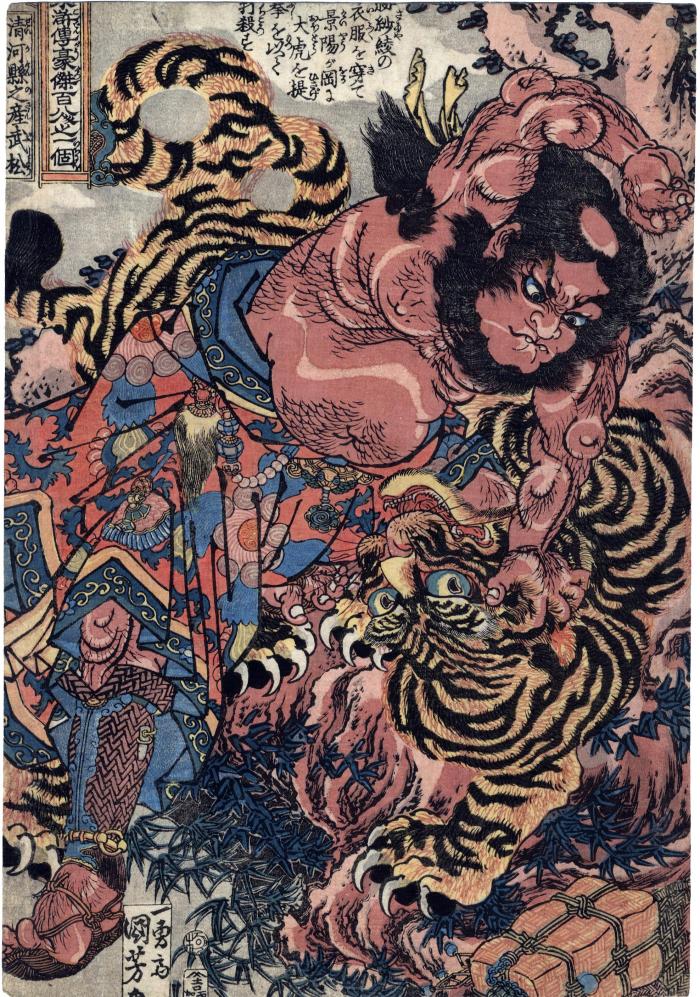Utagawa Kuniyoshi (歌川国芳) (artist 11/15/1797 – 03/05/1861)
Wu Song (Gyōjia Bushō - 清河縣之産武松) from the series One Hundred and Eight Heroes of the Shuihuzhuan (Suikoden gōketsu hyakuhachinin no hitori - 水滸伝豪傑百八人之一個)
ca 1827 – 1830
9.75 in x 14 in (Overall dimensions) Japanese woodblock print
Signed: Ichiyūsai Kuniyoshi ga
一勇斎国芳画
Publisher Kagaya Kichiemon
(Marks 195 - seal 22-025)
Censor's seal: kiwame
British Museum
Tokyo National Museum
Ashmolean Museum, University of Oxford
National Library of Australia
Royal Museums of Art and History, Belgium (via Cultural Japan)
Art Institute of Chicago The Ashmolean Museum in Oxford provides this information about this print:
Seiga-ken no Sanbushō was born in Seiga-ken (Qinghe xian), later becoming a 'gyōja', a Buddhist ascetic. He was much too fond of saké which frequently made him fighting drunk. On one occasion, Sanbushō, wearing his trade-mark red clothing and having drunk too much at a saké bar in Keiyōtō (Jingyanggang) was offered a bed by the landlord as there was a tiger lurking in the area that had already killed twenty-five people. Sanbushō laughed, ignored the innkeeper and left the bar. As expected, the infamous tiger appeared, and attacked Sanbushō. After a long and bloody battle, he finally killed the beast with his bare hands.In chapter 22 Bushō is on his way to visit his dwarf brother when he stops at an inn and partakes of food and wine with great gusto. He drinks so much that the innkeeper doubts whether Bushō will be able to continue safely on his journey, especially as a large tiger has recently been sighted in the vicinity. The tiger hunts at night and has already killed about twenty-five men. The innkeeper offers Bushō a place for the night: the hero simply bursts into laughter. He, Bushō, is a man and does not fear a tiger, at which point he departs and proceeds on his journey. In the middle of the night he is suddenly confronted by the infamous beast. His club splits into two as he tries to ward off the tiger's attack. Bushō continues to fight with his bare hands; after a bloody battle and repeated blows he finally kills the animal. The villagers see him as a valiant hero and as a token of their gratitude the magistrate awards the tiger-killer with a high military rank."
In this print, Sanbushō, who is firmly holding the tiger with his left hand, clenches his right fist and is about to give a blow to the tiger's head. This exploit became famous and he was rewarded by a local lord; he divided the prize-money among the local hunters, and thereafter became head of the lord's garrison.
****
"The adventures of Gyōjia Bushō gave rise to a number of popular stories in China which have been passed down from generation to generation. Bushō's most impressive exploit was his victory over a dangerous tiger and this is the subject of Kuniyoshi's print.
Quoted from: Of Brigands and Bravery by Inge Klompmakers, p. 76. Illustrated in a full-page, color reproduction on page 77.
This portrait of Gyōjia Bushō is one of the five prints in which the word Tsūzoku is omitted from the title cartouche; it is among the first five Suikoden prints by Kuniyoshi." (Ibid.)
****
There is another copy of this diptych at the McMaster Museum of Art in Hamilton, Ontario.
****
Illustrated in Ukiyo-e dai musha-e ten - 浮世絵大武者絵展 - (The Samurai World in Ukiyo-e), edited by Yuriko Iwakiri, Machida City Museum of Graphic Arts, 2003, #153, p. 58.
Kagaya Kichiemon (加賀屋吉右衛門) (publisher)
warrior prints (musha-e - 武者絵) (genre)
Suikoden (水滸傳) (genre)
